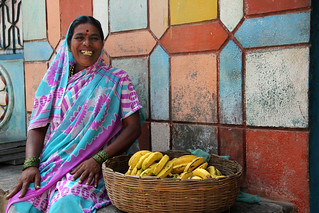
Note from Beth: Micro-lending and crowdfunding platforms are part of the sharing economy. While they don’t completely solve the issue of wealth distribution and equity, here’s an inspiring story about a micro lending platform called Milaap which is the Hindi word for connecting. They celebrate four years today and are sharing some tips for building a community a crowd funding campaign.
5 Ways to Build and Activate a Community for Your Crowdfunding Campaign guest post by Sourabh Sharma
I can remember it like it was yesterday. We were just three young entrepreneurs determined to make a difference; determined to find a way to help the working poor lift themselves from poverty. There had to be a better, more sustainable way for people to give meaningfully and we were steadfast on making it a reality. June 16, 2014 marks four years since we did just that by founding Milaap, a unique platform that blends micro lending and crowd funding in order to help the working poor start their own businesses and gain independence.
Building momentum for a cause you’re passionate about takes hard work, sweat and determination every single day. It requires more than just three young entrepreneurs with a dream. It means we had to use our passion to inspire a community of people to take action. We’ve learned a great deal in the past four years but one of the greatest lessons we’ve learned is summed up into five ways to build and activate a community for your cause.
- Make your call to action feasible: At Milaap every dollar is important. Instead of requiring a lender to fully fund the need of the borrower, which could range anywhere from $200-$1,000, we decided to make lending start as low as $25. This made it more feasible for more people to contribute to someone’s need and even get their “feet wet” with the lending experience. It’s a terrific way for people like me and you to help those who really deserve it.
- Tell your story: When we created our website we had one goal, to bring the story of the end-beneficiaries to life. To tell THEIR stories. We wanted people to come to our website and immediately gravitate to the heartfelt stories of borrowers, people who’ve pulled themselves out of poverty and improved the lives of their entire family.
Your website is your hub, your store front, and it’s a key element that every business or cause should invest wisely in. At Milaap we knew once these inspiring stories and imagery hooked people, they would then be inspired to learn more about Milaap and this different way of giving. Consequentially in just four short years we’ve raised over $1.5 million, given almost 10,000 loans and impacted more than 48,000 lives.
- Be transparent: You’ve heard it time and time again but transparency, especially in the digital age is key. Millennials are a cause passionate generation but they are also particularly more conscious of where their money is going and how it’s being spent (and why shouldn’t they be!). We created transparency by enabling lenders to choose where their money went (the cause) or to whom their money went (the individual). We have profiles on our site of the different borrowers, their stories, the amount of money they need and why, and a barometer of their progress. We also think it’s important to openly share the repayment term, the interest paid by each borrower, the total amount disbursed, the repayment rate (which is 98.7% on the entire portfolio), the amount of your contribution which goes to the borrower (100%) and how Milaap remains financially sustainable (by charging a 5% fee on the loans dispersed to its field partners and by raising funds from private individuals and institutions).
Relationships are built on trust and honesty, and building a community around your cause is no different.
- Be present: For all of us at Milaap this cause is personal to us. In order to make it personal to others we must be present. This means being present and active on every communication platform we’ve established with our community from Facebook to Twitter to email, if we’re not really and genuinely present on all of these platforms it will be apparent to our community. If your organization decides to create a Facebook page, that’s great, but make sure you invest your time and energy in that space as if you were in a room full of potential lenders or fundraisers. If you set up an email for people to send questions, make sure you personally respond in a timely manner. Being present also goes back to trust and transparency, by being present you grow trust which builds and strengthens your community.
- Take it one step further: Once someone has lent money to a cause, how do you keep them engaged? Inspiring your community and providing different ways for them to get involved is key to keeping them invested emotionally in your cause. The Hope Project, which shines a spotlight on former Devadasis (pronounced “day-vuh-daah-sees” and meaning “servants of God”). These are rural Indian women who, because of a centuries-old tradition (outlawed but still prevalent) were “dedicated” to serve their temple deity for the rest of their lives. Unfortunately, the system was abused, and many were forced into the sex trade. The #HopeProject aims to help these hardworking women rebuild their lives by starting their own businesses (the infographic below is a great visual representation of the impact the #HopeProject has on Devadasis). As part of this campaign we’ve focused on growing a group of Champions for the cause, people dedicated to taking lending one step further and inspiring their friends and family to do the same.
We’ve also provided other ways people can get involved with Milaap by starting their own lending campaign, sharing a blog post, participating in digital events such as Twitter chats and adding a Milaap widget on their website.
Shameless plug: Speaking of digital events, to celebrate four years of sustainable giving, Milaap is hosting a global, 24-hour online conversation today on sustainable giving. The 24-hour event includes activities such as live Google Hangouts with Milaap partners, a live Facebook chat with Catherine Rubin Kermorgant, author of “Servants of the Goddess” which is a fascinating account of her experience on making a documentary about Devadasis, and more. Learn more about the birthday event here and join us using #Milaap4Hope.
What lessons have you learned in building a community for your cause or non-profit? What would you add to this list?

Sourabh Sharma is the Co-founder & CEO of Milaap Social Ventures. You can find out how to lend a little and change a lot by visiting http://milaap.org/blog/champions-of-hope/ and learn more about Milaap at http://milaap.org/.
